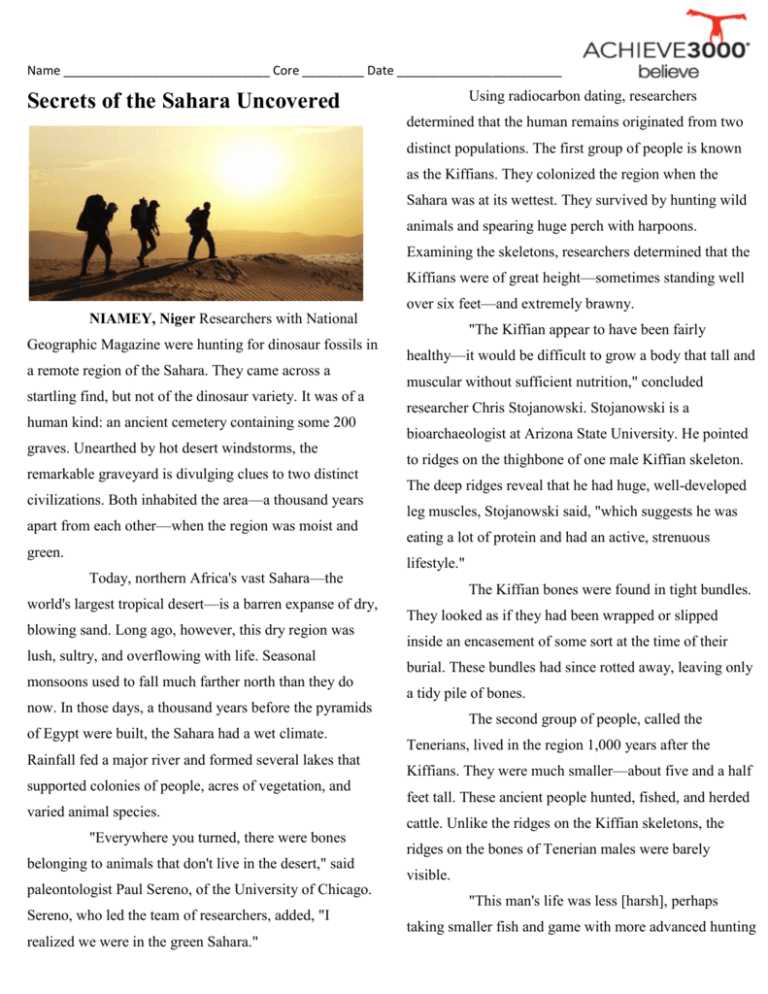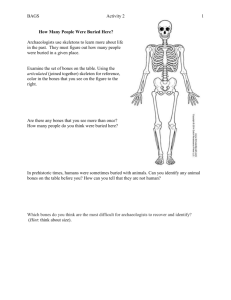Secrets of the Sahara Uncovered
advertisement

Name ______________________________ Core _________ Date ________________________ Using radiocarbon dating, researchers Secrets of the Sahara Uncovered determined that the human remains originated from two distinct populations. The first group of people is known as the Kiffians. They colonized the region when the Sahara was at its wettest. They survived by hunting wild animals and spearing huge perch with harpoons. Examining the skeletons, researchers determined that the Kiffians were of great height—sometimes standing well over six feet—and extremely brawny. NIAMEY, Niger Researchers with National Geographic Magazine were hunting for dinosaur fossils in a remote region of the Sahara. They came across a startling find, but not of the dinosaur variety. It was of a human kind: an ancient cemetery containing some 200 graves. Unearthed by hot desert windstorms, the remarkable graveyard is divulging clues to two distinct civilizations. Both inhabited the area—a thousand years apart from each other—when the region was moist and green. "The Kiffian appear to have been fairly healthy—it would be difficult to grow a body that tall and muscular without sufficient nutrition," concluded researcher Chris Stojanowski. Stojanowski is a bioarchaeologist at Arizona State University. He pointed to ridges on the thighbone of one male Kiffian skeleton. The deep ridges reveal that he had huge, well-developed leg muscles, Stojanowski said, "which suggests he was eating a lot of protein and had an active, strenuous lifestyle." Today, northern Africa's vast Sahara—the world's largest tropical desert—is a barren expanse of dry, blowing sand. Long ago, however, this dry region was lush, sultry, and overflowing with life. Seasonal monsoons used to fall much farther north than they do The Kiffian bones were found in tight bundles. They looked as if they had been wrapped or slipped inside an encasement of some sort at the time of their burial. These bundles had since rotted away, leaving only a tidy pile of bones. now. In those days, a thousand years before the pyramids of Egypt were built, the Sahara had a wet climate. Rainfall fed a major river and formed several lakes that supported colonies of people, acres of vegetation, and varied animal species. "Everywhere you turned, there were bones belonging to animals that don't live in the desert," said paleontologist Paul Sereno, of the University of Chicago. Sereno, who led the team of researchers, added, "I realized we were in the green Sahara." The second group of people, called the Tenerians, lived in the region 1,000 years after the Kiffians. They were much smaller—about five and a half feet tall. These ancient people hunted, fished, and herded cattle. Unlike the ridges on the Kiffian skeletons, the ridges on the bones of Tenerian males were barely visible. "This man's life was less [harsh], perhaps taking smaller fish and game with more advanced hunting technologies," Stojanowski said as he inspected the bones clams. They also discovered the fossils of animals, such of an adult male. as giraffes, elephants, hartebeests, and warthogs, all of The Tenerians adorned their dead with jewelry which tend to congregate near accessible watering holes. and posed their bodies in various positions. For example, Helene Jousse is a zooarchaeologist in Vienna, Austria. an adult Tenerian male was buried with his skull resting Jousse reported that these animals are common today. on part of a clay vessel. Another adult male was interred They are found hundreds of miles away, in the East seated on the shell of a mud turtle. Pollen remains reveal African country of Kenya. that one woman and two children, all holding hands, were carefully laid to rest on a bed of flowers. The cemetery was discovered very close to what would have been a lake at the time of these ancient civilizations. Nearby, researchers found remnants of marine animals, such as large fish, crocodiles, turtles, and "When you come across something like that in the middle of the desert it sends a tingle down your spine," said Paul Sereno. "Part of discovery is finding things that you least expect." Sereno's findings were published in the September 2008 issue of National Geographic Magazine. Dictionary congregate (verb) divulge (verb) expanse (noun) to gather to reveal a stretch or large area paleontologist (noun) a person who studies life in the ancient past radiocarbon dating (noun) a method used to determine the age of organic remains by measuring the amount of carbon they contain Multiple Choice: Circle the letter of the choice the best completes the statement. (2 points each) 1. According to the article, which of these best describes how the Kiffians and the Tenerians differed? A. The Kiffians appear to have been fairly strong and healthy, while the Tenerians appear not to have eaten any protein. B. The Kiffians buried their dead in specific B. What did the research team conclude from the pollen remains they found? C. What method did the research team use to analyze the human remains? D. Did the research team find the dinosaur fossils they were looking for? positions, while the Tenerians did not bury their 5. According to the article, why did researchers dead in any specific way. conclude that the Kiffians lived a more rigorous life C. The Kiffians buried their dead near remains of marine animals, while the Tenerians buried their dead near remains of land animals. D. The Kiffians were tall, muscular hunters who hunted wild animals, while the Tenerians were smaller people who hunted smaller game. 2. Which of these events took place first? A. A population of Tenerian people was buried in a cemetery near a lake. B. A cemetery housing 200 graves was uncovered by hot desert windstorms. C. A population of animal fossils was found near a graveyard in the Sahara. D. A cemetery in the Sahara was used to bury a population of Kiffian people. 3. Which is the closest synonym for the word congregate? A. Assemble B. Console C. Assert D. Comprehend 4. Which question is not answered by the article? A. Did the research team find any ridges on the bones of Tenerian males? than the Tenerians? A. The bones of the Kiffian skeletons revealed deep ridges that indicated huge, well-developed leg muscles. B. The Kiffians buried their dead in very deep graves, for which they had to dig more than six feet underground. C. The Kiffians were buried together with harpoons and spears rather than the flowers and jewelry buried with Tenerians. D. The bones of the Kiffians had all rotted away because their lifestyle caused them to decay more quickly. 6. Which of these is a statement of opinion? A. The skeletal bones of the Kiffian population were found in tight, tidy bundles. B. National Geographic Magazine was lucky to have their team find the cemetery. C. National Geographic Magazine published the findings of the research team. D. The skeletons of the Tenerian population were found posed in various positions. 7. The article states: The deep ridges reveal that he 8. Which of these is most important to include in a had huge, well-developed leg muscles, he said, summary of this article? "which suggests he was eating a lot of protein and had an active, strenuous lifestyle." Which would be the closest synonym for the word strenuous? A. Traumatic B. Temporary C. Depriving D. Demanding A. Researchers discovered an ancient cemetery containing some 200 graves. B. Team leader Paul Sereno works with the University of Chicago. C. The skeleton of one adult male Tenerian was found interred seated on the shell of a turtle. D. Kenya, an East African country, is currently home to giraffes, hartebeests, and elephants. Opinion Question: Which do you consider most interesting? The Sahara had several lakes, acres of vegetation, and a moist climate. People who lived a thousand years apart made their cemeteries in the same location. The people lived before the pyramids were built. One group of people was of great height and the other was small. Thought Question: You have traveled back in time and are a member of either the Kiffian or the Tenerian people. Describe your life, including details about the people and their environment. Include information from the article, as well as your own ideas, in your response. (5 points) Math- In the Sahara Desert, scientists found graves from two different groups of people: Kiffians and Tenerians. The two groups lived 1,000 years apart from one another. One century is the same as 100 years. How many centuries apart did the two groups live? A. 90 centuries B. 10 centuries C. 20 centuries D. 100 centuries







